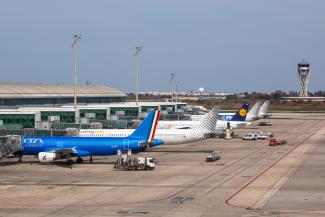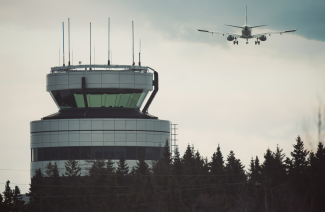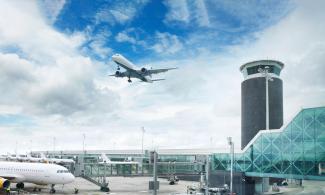Remotely Piloted Aircraft Systems (RPAS), more popularly known as drones, are increasingly flying in our skies due to the rapid development of enabling technologies and the increasing number of services they can deliver. Leisure drones alone are estimated to be around 1.5M units in Europe with a yearly growth rate close to 100% as observed in the past few years. This means that by 2020 more than 5M leisure drones are expected if the trend continues.
RPAS are not a new phenomenon: they date back to the mid-18th century, but until a few years ago their use was almost exclusively confined to military applications. Their great potential for developing innovative applications, however, is increasingly recognised in the civil sector as well.
Applications
Civil applications are increasing at a fast rate, typically to provide existing services in a cheaper and safer way than the expensive classical alternatives relying on helicopters and human operators, in particular in the following fields:
- In agriculture drones are enabling the smart farming revolution thanks to precise real-time data gathering and processing that can support the entire biological lifecycle: from the analysis of soil and field, to efficient planting, from the crop and livestock monitoring to the intelligent irrigation and spraying;
- Drones are a natural candidate also for inspections of critical assets, especially of constructions and utility networks, since they can conveniently access powerline installations, gas pipelines, solar installations, wind turbines, telecommunication towers, providing a visual assessment of their status and executing some elementary maintenance tasks;
- Drones are also cutting times and investments to perform land surveying through GIS mapping, Lidar 3D mapping, cartography, geophysical mapping and surveying, providing a level of accuracy higher than conventional methods relying on people on the field at a cost-effective rate;
- In aerial photography and videography, either for commercial applications such as real estate agents or filmmakers, but also for recreational purposes, drones are used by a growing army of professionals and hobbyists, combining the passion for flying and photography.
- Governments and specialized agencies are also increasingly relying on drones for security and surveillance tasks (civil security during big events, traffic monitoring, border surveillance,…) as well as for Search and Rescue missions (search for missing persons, emergency response, post-disaster operations...).
The most innovation-centered Companies around the world are also experimenting the use of drones to deliver new added value services. Amazon and Google are working on the technologies to enable the use of fleets of drones for parcel delivery. Facebook is working on a drone solution providing internet access in remote areas of the world but in the long term drones can even turn into an option for air transportation: Airbus is developing its vision for Po.Up, i.e. a car that can be airlifted by a drone, while Uber expects to deploy its flying taxis in by 2020.
The sky is (literarily) the limit: while technology progresses, its reliability increases and the cost to consumer falls, thus creating the conditions for the creation of new markets and services. Therefore, the main limit to the creativity of citizens and entrepreneurs in developing drones applications is represented by the existing airspace and aircraft regulations.
Expected impact
The impact that civil drones will ultimately generate on the European economy is expected to be around 10% of the overall direct impact of aviation. It may exceed the value of EUR 10B by 2035, and that of EUR 15 billion by 2050 as analysed by the SESAR JU. This includes the whole value chain, from the design and the production of the drones and the related remote control technologies (up to 2,5B€), up to the delivery of services and operations (up to 10 B€) and maintenance and insurance (up to 2,5B€), creating an additional 240000 jobs.
 Source: "European Drones Outlook Study: Unlocking the value for Europe"
Source: "European Drones Outlook Study: Unlocking the value for Europe"
This flying revolution is however bringing a weighty payload of concerns by many actors. Safety is the first one since drones imply a risk both in the air (risk of collisions with other manned or unmanned aircraft) and on the ground since the loss of power or control may imply crashes over inhabited zones. The intrusion into protected zones and the capturing of images from unequalled perspectives also imply concerns for security and violation of privacy both for citizens and for enterprises. The impact of environment in terms of noise of the propellers is also an element of societal concern.
The current challenge for European and National authorities worldwide is therefore to develop a set of rules and an appropriate infrastructure that will satisfactorily address those concerns, allowing at the same time the market for drones’ services to fully develop its potential and generate economic growth.
Regulatory framework
The wide variety of machines and applications represented by drones represent a challenge for the regulator to tackle in a unique set of coherent, proportional, efficient and safe regulations.
In Europe so far the regulation of drones under 150kg falls within the competence of Member States and this has contributed to create a fragmentation in terms of categorisations, operational limitations and remote-pilot competence required among different Countries, hampering the development of a single EU market for UAS and cross-border UAS operations.
However the EASA is working on a proposal for a new basic Regulation, currently under discussion between the Council, the European Commission, and the European Parliament that aims at extending the competence of the EU to regulate all drones regardless of their weight.
The proposal is based on a categorization of drones based on the risk of their operations, dividing into: ‘Open category’ (low‑risk), ‘Specific category’ (medium‑risk) and ‘Certified category’ (high‑risk). It specifically focuses on the ‘open’ and ‘specific’ categories as the newest and fastest evolving ones, while the requirements for the ‘certified’ category will be included as amendments to existing manned aircraft regulations.
Depending on the category, the proposed Regulation include different technical and operational requirements covering inter alia:
- The registration of drones and operators within the designated entity either at national or at EU level.
- The electronic identification functionality, to identify a flying drone without direct physical access to that aircraft.
- The geofencing, i.e. a virtual geographic boundary, defined for instance by GNSS technology that enable software to prevent a drone entering a defined zone.
In parallel, the SESAR JU is defining the concept of U-Space, i.e. the services and procedures needed to ensure the safe, efficient and secure operations of drones in our skies. The objective by 2019 is to establish the initial set of foundation services (i.e. U1) for electronic registration, identification and geofencing to users. These will be later expanded to more complex planning, management and assistance services in U2 and will culminate with advanced services aimed at guaranteeing the full integration with manned aviation in the long run (U3 and U4).
 Source: SJU U-Space Blueprint
Source: SJU U-Space Blueprint
The current blueprint will be incorporated into an addendum relative to the integration of drones into the European ATM Master Plan that should be adopted by the end of 2018.
At the same time the EUROCAE is starting to develop standards for geo-fencing and e-identification. Both activities will be kicked-off later this month in Brussels, right after the publication of the Helsinki Declaration, urging European authorities to come forward with clear indications on the intended regulatory plans and open standards.
In the meanwhile the European Commission is developing a multilingual portal, to raise awareness of professional and recreational users on the basic recommended practices and regulations for drones operations.
The other civil aviation authorities, service providers and operators at National and regional levels have a number of challenges in front of them to adapt their services to the new requirements and to ensure the availability of sufficient resources and skills to satisfy the increasing demand.
At ALG we are directly involved in all these work streams at the EU level and we can support all aviation stakeholders in aligning their current strategies and adequately planning for the evolution, in order to convert drones from an additional burden into an opportunity to strengthen competitiveness and increase their revenue streams.











































































